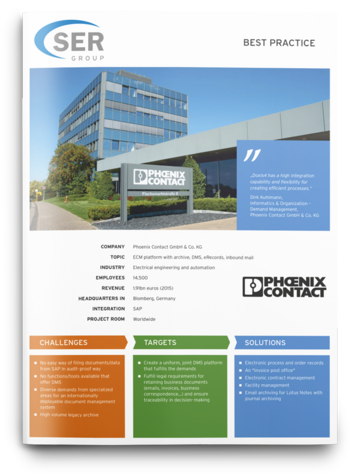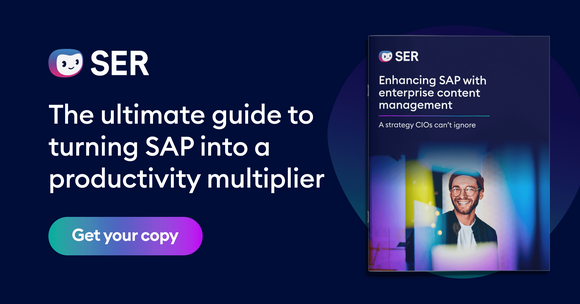SER Blog Innovation & Technology
Microsoft Dynamics Business Central as part of an ECM platform
Christian Bley
AI is enabling us for the first time to analyze and evaluate huge amounts of data at the same speed as we generate it. In business, most of these data are generated in an ERP system, such as Microsoft Dynamics 365 Business Central. As a result, this article examines the following questions: How can I expand Business Central and make it part of an enterprise content management (ECM) platform? What are the challenges, and how will this step benefit me?

Business Central: Function and role in business
Microsoft Dynamics 365 Business Central (formerly NAV) is a comprehensive ERP solution that supports a variety of business processes. From financial management to production to sales and customer service, Business Central provides a wide range of functions that help companies operate efficiently. As a central platform for business data, Business Central plays an important role in managing commercial information and processes.
Enterprise content management: Concepts and objectives
ECM can be understood as a comprehensive concept that aims to manage, process, and archive all of a business’s information in a consistent way. Components such as document management, process management or collaboration play an important role in the ECM landscape. In addition, ECM aims to consolidate the various data silos or to network them with each other so that information can be accessed consistently across the enterprise. The Doxis ECM system can provide you with a strong platform designed especially to achieve these goals.
What challenges do we face today?
The digital transformation
This transformation process is not limited to a single system, but affects a wide variety of areas. Projects are often initiated by specialist departments. However, since processes almost never stop at an application boundary, a more comprehensive view usually takes into account different systems. This increases the complexity. A local project can quickly become a cross-departmental issue, which not only brings other stakeholders into play, but also additional goals, concerns and, last but not least, other information systems.
Different data silos
We use different systems for a wide variety of tasks. Each system serves a specific purpose and generates new data every day. The problem now is that these data silos are initially proprietary. So the challenge is to ensure availability in other systems, i.e. to connect the data silos in an effective way. A classic example is data for leads and prospects in a CRM system, which can be imported to the financial accounting software as customer data at a certain time.
Legal regulations
Internal compliance guidelines and legal regulations have to be considered in a timely manner to ensure sufficient lead time for implementation. It is particularly important to ensure that the integrity of data is maintained and that no information is lost when data are transferred to other systems. However, it is also important to take into account the handling of information, which can be decisive for ensuring the right data quality. Aside from the obligations that have to be met, these can also turn out to be great opportunities. For example, the laws for electronic invoicing, on one hand, require companies to take action. On the other hand, an enormous gain in efficiency can be crystallized from this process. Not only for individual businesses, but for the entire economy in Germany.

Document management guide
How can a DMS boost your organization’s efficiency? Which system is right for you? This practical guide helps you to find & implement the right DMS. Incl. checklists, real-life examples, etc.
Read nowObjective of integrating Business Central in an ECM platform
The previous example, in particular, shows that one can also find opportunities in challenges. Yet what are the objectives of integration?
Managing the flood of information
In the years ahead, we will generate more rather than less information. Developments in the area of AI, in particular, ensure that we can generate and process data of a certain quality and volume more quickly and easily. An ECM is responsible for ensuring that information is prepared in such a way that it can be reused and recycled. For example, in an ECM, documents from Business Central, as well as emails or documents from other applications, are aggregated in one process and are then displayed in context in Business Central.
Improving efficiency
Every system serves a specific purpose. Often, non-related functions are implemented in the ERP with major effort, and then they have to be maintained. An ECM platform such as Doxis Intelligent Content Automation (ICA) specifically expands the ERP with these functions using its own standards. Instead of developing a new system, the ECM only needs to be adapted. This not only ensures cost efficiency, but it also promotes functional efficiency, as each system on the platform can play to its strengths.
Reducing costs
You can reduce costs in more ways than simply through initial implementation. An ECM can help you reduce your operating costs by optimizing processes and improving consistency. For example, data that were previously entered manually can be extracted automatically, resulting in a more efficient process. Or, you can avoid data redundancies in individual systems that may have previously required added effort to maintain.
Integrating Business Central in the Doxis ICA platform
Choice of operating model
Anyone setting up a new system today first has to choose an operating model. Does the business have a cloud strategy already? What are its goals?
Doxis ICA offers different options and can be operated both in the cloud and in your own on-premise data center. Both SaaS and PaaS architectures are available across different tiers. Hybrid scenarios are also possible. AI functions are often used from the cloud, while the ERP or DMS systems store data locally.
Two use cases for Business Central integration in Doxis
Outbound documents in sales
Information from Business Central has to be made available elsewhere. As a result, the documents generated and master data are delivered via interface directly to the Doxis ECM platform. It automatically checks whether the information exists already or whether new objects such as files and structures need to be created. Versioning of existing documents is also supported. If a user creates a sales order with associated delivery notes and invoices in Business Central, these data are transferred immediately to Doxis, where they are available for further use in applications and processes. Other systems also contribute to this central data storage layer. For example, the email from Outlook or the quote from Salesforce can be archived in Doxis. Ultimately, all of this information is published in Business Central, so that users not only have access to Business Central documents but also to all information in the context of its latest business transaction, regardless where it was created.
Processing electronic invoices
Electronic invoices have a special format. Doxis uses its own classification components to help businesses read these invoices. On one hand, the machine-readable format is rendered in a form readable by users. On the other hand, the special structure of the XML is interpreted and the invoice data are captured. After the invoice has been checked as part of a digital workflow, which also takes place in Doxis, the invoice data are transferred to Business Central and an unposted purchase invoice is created. An invoice monitor provides accounting users with an overview of all invoices in circulation in the business at any time with only a click.

Phoenix Contact: ECM solutions for multiple departments
Phoenix Contact GmbH uses Doxis's archiving, DMS, contract management, invoice and order management functions, as well as various eFiles.
Read nowBenefits of integrating Microsoft Dynamics Business Central in an ECM platform
The two examples above already give an idea of the benefits of integrating Business Central in an ECM platform such as Doxis.
Transparency and traceability
All information at a glance, regardless where it was created. With an ECM as the central platform for storing documents, users and applications have a direct point of contact when researching information. Thanks to predefined processes and comprehensive logging, users can always see what has happened to a document, where it is currently located, or whether there are any tasks for future processing. This enhances Business Central with DMS functionality.
Avoiding media disruptions and improving continuity
Processes often suffer from media disruptions due to a lack of existing interfaces. Here’s one fatal example: printing out an email only to then scan it again somewhere else. An ECM can support businesses in enterprise-wide digitalization processes, and ensure that media disruptions are prevented and processes are fully end-to-end.
Improving teamwork
Collaboration at the level of specialist teams but also interdisciplinary teamwork depends on communication and information channels. An ECM platform can promote collaboration, and it provides the shared data to do so, ensuring that everyone has access to the same data or version. Instead of focusing on how to get the information they need, users can instead spend more time on their core activities. Thanks to integration, access is possible from Business Central or generally from the leading system.
Greater benefits with fewer costs
It might sound like a tired marketing slogan, but after closer inspection it’s not so far-fetched. Businesses often try to develop functions in software not intended for this purpose. These expenses can be avoided by using standard solutions from the existing ECM platform. This also pays off later when solutions need to be updated. It can also make a difference whether a Microsoft license has to be purchased to implement a requirement or whether you can draw from your existing license pool by connecting to the ECM.
Some old trends return
It should come as no surprise that artificial intelligence has an important role to play currently and in the future. As mentioned at the start of this article, the amount of information will continue to grow, and AI will become increasingly important for ensuring we can use this information. Today, ChatGPT and others mainly use freely accessible information on the internet when providing answers. Microsoft's Copilot works reliably in the Microsoft cosmos. However, if you use a language model such as ChatGPT with the content of your ECM system, the answer will be based on all of your own business information, regardless of whether or not you are working in Microsoft or Business Central. This means that the quality and relevance of your answers will be much higher. In the coming months and years, there will be a lot of changes in this area.
Doxis ECM and Microsoft Dynamics Business Central
Connecting Business Central to an ECM system ensures that the full potential of both applications is utilized. These synergy effects increase automatically the more systems you integrate in your ECM platform. As an ECM platform, Doxis expands Business Central with important core functions relating to document management, workflow, capture, collaboration, and artificial intelligence.
We understand that integrations are often challenging, but in the end the reward is an exponential return on your investment.
Christian Bley
Hi, I'm Chris Bley, Solution Engineer at SER. For 15 years, I have been advising my customers on all aspects of digitalisation, developing concepts and implementing projects in this area. A significant part of my work consists of imparting my knowledge. In addition to organising workshops, I therefore create a lot of content in the form of articles, videos, white papers and much more. If there is still creative energy left at the end of the day, it flows into my recording studio and new song lyrics.

The latest digitization trends, laws and guidelines, and helpful tips straight to your inbox: Subscribe to our newsletter.
How can we help you?
+49 (0) 30 498582-0Your message has reached us!
We appreciate your interest and will get back to you shortly.




